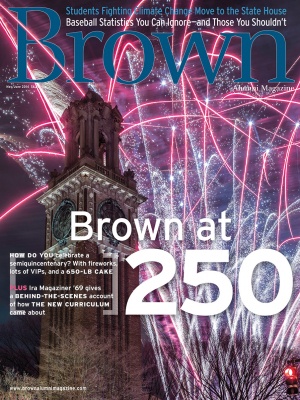I arrived at Brown just as the wrapping paper was being torn off Hunter Lab (“What’s in a Building?” March/April). Even as an eighteen-year-old, I knew it was something of a dud—all buttoned up, a visual metaphor for the so-called Silent Generation. Fireproof it was, and proof to any spark of imagination. Now, as the latest outcome of the Kliment/Halsband master-planning of the previous decade, and thanks to the talent of architect Toshiko Mori and the support of the University, gray flannel gives over to the age of Aquarius; the sun shines into and from within the building. It’s a powerful story well told. Thank you for telling it.
Raymond P. Rhinehart ’62
Washington, D.C.
I admire the architectural and academic innovation in the creation of BERT, based on the shell of Hunter Lab, but your piece misses important historical context, both for Brown and for the discipline of psychology and its basic-science roots.
The design of Hunter Lab under the direction of Professor Harold Schlosberg, psychology’s illustrious chair at the time, was a landmark accomplishment for the field as a whole. Built on a shoestring budget, thanks to a cost-share of $1.5 million by John D. Rockefeller Jr. and the U.S. Public Health Service, Hunter Lab set a creative standard for teaching and research facilities that was emulated nationwide. After years of department deliberation on how to serve the students and their researcher-professors most effectively, Schlosberg published a charming prescription for essential building elements in the American Journal of Psychology the summer after Hunter Lab opened.
The administration needed convincing about what would be going on in the two suites with “windowless little rooms” surrounded by the foreboding windowless first-floor exterior. In fact, these were essential for producing unconfounded data that would help turn countless students toward careers in psychology. In a fifty-year retrospective, also published in the American Journal of Psychology, Professors Julius W. Kling, Donald S. Blough, and Russell M. Church (all three my dissertation advisers!) noted that “the absence of first-floor windows on the Waterman Street façade caused some comment from viewers for the first year or two.” Apparently, as you noted, that perception persisted quite a bit longer. In itself, though, the protection it provided for controlled experiments should not be a pretext for criticizing the building’s specialized functionality. It was basic to its success.
With ten of its faculty and graduate students having been elected to the National Academy of Sciences, Professor Schlosberg’s leadership in research, teaching, and building is a golden note in Brown’s history.
Michael Terman ’66 ScM, ’68 PhD
New York City





